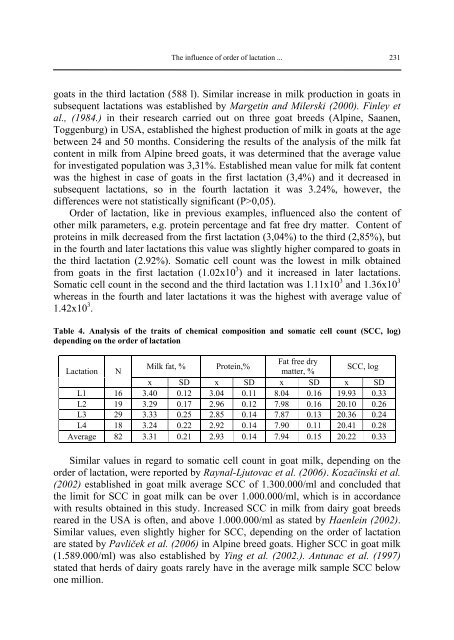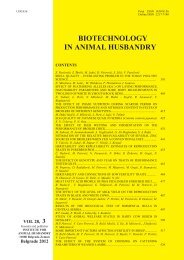Biotechnology in Animal Husbandry - Institut za Stočarstvo
Biotechnology in Animal Husbandry - Institut za Stočarstvo
Biotechnology in Animal Husbandry - Institut za Stočarstvo
Create successful ePaper yourself
Turn your PDF publications into a flip-book with our unique Google optimized e-Paper software.
The <strong>in</strong>fluence of order of lactation ...<br />
goats <strong>in</strong> the third lactation (588 l). Similar <strong>in</strong>crease <strong>in</strong> milk production <strong>in</strong> goats <strong>in</strong><br />
subsequent lactations was established by Marget<strong>in</strong> and Milerski (2000). F<strong>in</strong>ley et<br />
al., (1984.) <strong>in</strong> their research carried out on three goat breeds (Alp<strong>in</strong>e, Saanen,<br />
Toggenburg) <strong>in</strong> USA, established the highest production of milk <strong>in</strong> goats at the age<br />
between 24 and 50 months. Consider<strong>in</strong>g the results of the analysis of the milk fat<br />
content <strong>in</strong> milk from Alp<strong>in</strong>e breed goats, it was determ<strong>in</strong>ed that the average value<br />
for <strong>in</strong>vestigated population was 3,31%. Established mean value for milk fat content<br />
was the highest <strong>in</strong> case of goats <strong>in</strong> the first lactation (3,4%) and it decreased <strong>in</strong><br />
subsequent lactations, so <strong>in</strong> the fourth lactation it was 3.24%, however, the<br />
differences were not statistically significant (P>0,05).<br />
Order of lactation, like <strong>in</strong> previous examples, <strong>in</strong>fluenced also the content of<br />
other milk parameters, e.g. prote<strong>in</strong> percentage and fat free dry matter. Content of<br />
prote<strong>in</strong>s <strong>in</strong> milk decreased from the first lactation (3,04%) to the third (2,85%), but<br />
<strong>in</strong> the fourth and later lactations this value was slightly higher compared to goats <strong>in</strong><br />
the third lactation (2.92%). Somatic cell count was the lowest <strong>in</strong> milk obta<strong>in</strong>ed<br />
from goats <strong>in</strong> the first lactation (1.02x10 3 ) and it <strong>in</strong>creased <strong>in</strong> later lactations.<br />
Somatic cell count <strong>in</strong> the second and the third lactation was 1.11x10 3 and 1.36x10 3<br />
whereas <strong>in</strong> the fourth and later lactations it was the highest with average value of<br />
1.42x10 3 .<br />
Table 4. Analysis of the traits of chemical composition and somatic cell count (SCC, log)<br />
depend<strong>in</strong>g on the order of lactation<br />
Lactation N<br />
Milk fat, % Prote<strong>in</strong>,%<br />
Fat free dry<br />
matter, %<br />
SCC, log<br />
x SD x SD x SD x SD<br />
L1 16 3.40 0.12 3.04 0.11 8.04 0.16 19.93 0.33<br />
L2 19 3.29 0.17 2.96 0.12 7.98 0.16 20.10 0.26<br />
L3 29 3.33 0.25 2.85 0.14 7.87 0.13 20.36 0.24<br />
L4 18 3.24 0.22 2.92 0.14 7.90 0.11 20.41 0.28<br />
Average 82 3.31 0.21 2.93 0.14 7.94 0.15 20.22 0.33<br />
Similar values <strong>in</strong> regard to somatic cell count <strong>in</strong> goat milk, depend<strong>in</strong>g on the<br />
order of lactation, were reported by Raynal-Ljutovac et al. (2006). Ko<strong>za</strong>č<strong>in</strong>ski et al.<br />
(2002) established <strong>in</strong> goat milk average SCC of 1.300.000/ml and concluded that<br />
the limit for SCC <strong>in</strong> goat milk can be over 1.000.000/ml, which is <strong>in</strong> accordance<br />
with results obta<strong>in</strong>ed <strong>in</strong> this study. Increased SCC <strong>in</strong> milk from dairy goat breeds<br />
reared <strong>in</strong> the USA is often, and above 1.000.000/ml as stated by Haenle<strong>in</strong> (2002).<br />
Similar values, even slightly higher for SCC, depend<strong>in</strong>g on the order of lactation<br />
are stated by Pavliček et al. (2006) <strong>in</strong> Alp<strong>in</strong>e breed goats. Higher SCC <strong>in</strong> goat milk<br />
(1.589.000/ml) was also established by Y<strong>in</strong>g et al. (2002.). Antunac et al. (1997)<br />
stated that herds of dairy goats rarely have <strong>in</strong> the average milk sample SCC below<br />
one million.<br />
231




